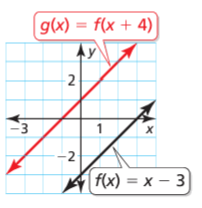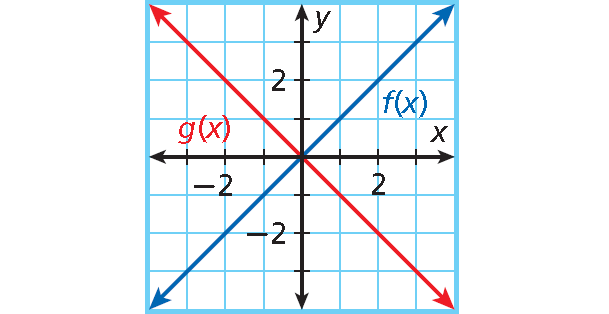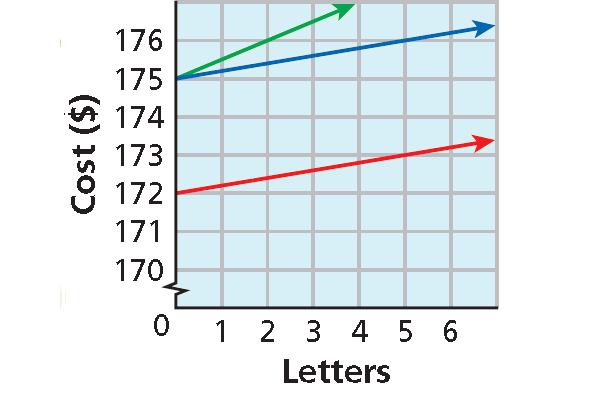TRANSFORMING LINEAR FUNCTIONS WORKSHEET
Subscribe to our ▶️ YouTube channel 🔴 for the latest videos, updates, and tips.
Problem 1 :
Graph f(x) = x and g(x) = x - 5. Then describe the transformation from the graph of f(x) to the graph of g(x).
Problem 2 :
Graph f(x) = x + 2 and g(x) = 2x + 2. Then describe the transformation from the graph of f(x) to the graph of g (x) .
Problems 3-4 : Graph f(x). Then reflect the graph of f(x) across the y-axis. Write a function g(x) to describe the new graph.
Problem 3 :
f(x) = x
Problem 4 :
f(x) = -4x - 1
Problem 5 :
Graph f(x) = x and g(x) = 3x + 1. Then describe the transformations from the graph of f(x) to the graph of g(x).
Problem 6 :
A trophy company charges $175 for a trophy plus $0.20 per letter for the engraving. The total charge for a trophy with x letters is given by the function f(x) = 0.20x + 175. How will the graph change if the trophy’s cost is lowered to $172? if the charge per letter is raised to $0.50?
Problem 7 :
Graph f(x) = x and g(x) = −2x + 3. Describe the transformations from the graph of f to the graph of g.
Problem 8 :
A cable company charges customers $60 per month for its service, with no installation fee. The cost to a customer is represented by c(m) = 60m, where m is the number of months of service. To attract new customers, the cable company reduces the monthly fee to $30 but adds an installation fee of $45. The cost to a new customer is represented by r(m) = 30m + 45, where m is the number of months of service. Describe the transformations from the graph of c to the graph of r.
Use the graphs of f and g to describe the transformation from the graph of f to the graph of g.
Problem 9 :

Problem 10 :


Detailed Answer Key
1. Answer :

The graph of g(x) = x - 5 is the result of translating the graph of f(x) = x, 5 units down.
2. Answer :

The graph of g(x) = 2x + 2 is the result of rotating the graph of f(x) = x + 2 about (0, 2). The graph of g(x) is steeper than the graph of f(x).
3. Answer :
To find g(x), multiply the value of m by -1.
In f(x) = x, m = 1.
1(-1) = -1 This is the value of m for g(x).
g(x) = -x

4. Answer :
To find g(x), multiply the value of m by -1.
In f(x) = -4x - 1, m = -4.
-4(-1) = 4 This is the value of m for g(x).
g(x) = 4x - 1

5. Answer :
- Find transformations of f(x) = x that will result in g(x) = 3x + 1 :
- Multiply f(x) by 3 to get h(x) = 3x. This rotates the graph about (0, 0) and makes it steeper.
- Then add 1 to h(x) to get g(x) = 3x + 1. This translates the graph 1 unit up.
The transformations are a rotation and a translation.

6. Answer :
f(x) = 0.20x + 175 is graphed in blue.
If the trophy’s cost is lowered to $172, the new function is g(x) = 0.20x + 172. The original graph will be translated 3 units down.
If the charge per letter is raised to $0.50, the new function is h(x) = 0.50x + 175. The original graph will be rotated about (0, 175) and become steeper.

7. Answer :
Given that f(x) = x
Note that you can rewrite g as g(x) = −2f(x) + 3.

Step 1 :
There is no horizontal translation from the graph of f to the graph of g.
Step 2 :
Stretch the graph of f vertically by a factor of 2 to get the graph of h(x) = 2x.
Step 3 :
Reflect the graph of h in the x-axis to get the graph of r(x) = −2x.
Step 4 :
Translate the graph of r vertically 3 units up to get the graph of g(x) = −2x + 3.
8. Answer :
Note that you can rewrite r as r(m) = (1/2) c(m) + 45. In this form, you can use the order of operations to get the outputs of r from the outputs of c.
First, multiply the outputs of c by 1/2 to get h(m) = 30m.
Then add 45 to the outputs of h to get r(m) = 30m + 45.

The transformations are a vertical shrink by a factor of (1/2) and then a vertical translation 45 units up.
9 Answer :
Given that f(x) = -2x
g(x) = f(x) + 2
g(x) = -2x + 2

g(x) = f(x) + 2
g(x) = -2x + 2
The graph is moved towards up 2 units.
10 Answer :
Given that f(x) = x - 3
g(x) = f(x + 4)
g(x) = x + 4 - 3
= x + 1

Moving the graph towards left of 4 units.
Subscribe to our ▶️ YouTube channel 🔴 for the latest videos, updates, and tips.
Kindly mail your feedback to v4formath@gmail.com
We always appreciate your feedback.
About Us | Contact Us | Privacy Policy
©All rights reserved. onlinemath4all.com

Recent Articles
-
10 Hard SAT Math Questions (Part - 38)
Dec 29, 25 04:21 AM
10 Hard SAT Math Questions (Part - 38) -
10 Hard SAT Math Questions (Part - 39)
Dec 28, 25 11:20 PM
10 Hard SAT Math Questions (Part - 39) -
10 Hard SAT Math Questions (Part - 41)
Dec 28, 25 06:05 PM
10 Hard SAT Math Questions (Part - 41)

